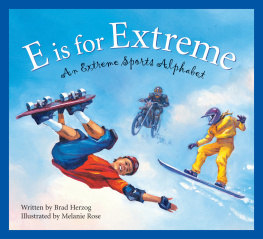Contents
Guide

The author and publisher have provided this e-book to you for your personal use only. You may not make this e-book publicly available in any way. Copyright infringement is against the law. If you believe the copy of this e-book you are reading infringes on the authors copyright, please notify the publisher at: us.macmillanusa.com/piracy.
Please note that some of the links referenced in this work are no longer active.
For Alec, Will, and Lizzie,
who go bigger, higher, faster

WE LIKE TO test ourselves. Can I lift this rock? Can I jump over this stream? Can I balance on one foot on this ledge? How far, how fast, how long can I go? Can I push beyond what I think is possible? As long as humans have been on the planet, weve been testing limits and trying to do new things.
For thousands of years, people lived side by side with danger: wild animals, severe weather, difficult terrain, hostile neighbors. How individuals handled fear in the face of danger often determined whether they lived or died.
In the past few decades, however, weve seen a huge emphasis on safety. All kinds of traditional playground equipment such as monkey bars, teeter-totters, and merry-go-rounds have been removed for being too dangerous. Mats and pads have been installed to provide a soft surface for anybody falling. Popular games like king of the hill and dodgeball have been eliminated for being unsafe.
Teachers, principals, and parents have been trying to make things safer and safer. During the same period weve also seen a huge surge in participation in extreme sports, also known as action sports or adventure sports. And everybody knows that whatever theyre called, these sports are dangerous.
Extreme sports are not a fixed group. They change every day because of the dedication, creativity, and originality of the people who participate in them. This book is an introduction to the wide world of extreme sports. It doesnt cover everything, but it provides a glimpse of whats available and what you might like to explore.
Who knows? Maybe like Alan Ollie Gelfand youll invent a skateboard trick that becomes so important that millions of people will use your nickname as they copy what you created. Who knows? Maybe like David Belle and Sbastien Foucan youll invent your own extreme sport like they did with parkour and free running. Who knows? Maybe like Shaun White youll become a gold medal winner in the winter and summer X Games and at the Olympics. Who knows? Maybe youll be happy hanging out with your friends and supporting one another as you perform tricks youve never done before.
Welcome to the exciting world of extreme sports. Dig in and discover what interests you. And always remember the two words of advice that athletes in these sports offer over and over: Have fun.
A RE YOU CRAZY about extreme sports? Are you eager to try new ways to go bigger, higher, faster? Are you willing to put in the work to master a new trick and go right on to the next one? Then this book is for you.
Extreme sports have exploded in popularity. Many of them developed as a reaction against traditional sports like baseball, football, basketball, and soccer. Those sports emphasize fitting in and being part of a team with a coach, assistant coaches, uniforms, and structured practices. Instead of following the rules like traditional sports, extreme sports focus on freedom, originality, and creating your own way of doing things.
Parents are much more heavily involved in traditional sports as coaches, spectators, and referees of young athletes. In extreme sports, athletes usually practice away from parents with their concerns and suggestions. Instead of coaches telling them what to do and how to do it, extreme-sport athletes figure out what they can do on their own or by talking to friends. Using trial and error and knowing that taking falls is part of the process, they define, refine, and push the limits of what they can do.
These sports are attractive to a much younger age group than traditional sports. The average age of people watching some baseball games is now over sixty. Many extreme-sport athletes are attracted to their sports because they want to be participants, not spectators. Rather than traditional sports that have been around for over 100 years, they want to participate in something new and exciting. They want to create new tricks to amaze themselves and change what everybody else thought was possible.
Ive always been a guy who wants to play sports, not watch them.
Shaun White, snowboarder and skateboarder
No violence, no competition, no groups, no chiefs.
Sbastien Foucan, free runner

W HATS IN A name? Quite a bit. With its focus on being an individual, taking risks, and testing limits, the term extreme sports separated these new sports from other sports. They were more extreme with athletes dealing directly with danger and putting their lives on the line. As these sports grew, the word extreme proved attractive to marketers of many products as well.
Over time, some people rebelled against the term extreme sports . They objected to extreme being used to market sports drinks, shampoo, and deodorant. They objected to their sports being defined in a limited way compared with traditional sports. They didnt like the label extreme when they were growing faster and attracting more athletes than sports like baseball.
Some people used the name adventure sports , but this too was based on a comparison with traditional sports. The new sports were more adventurous, but adventure sports didnt capture the sense of working day after day to perfect a move or develop a new trick. Adventure is an aspect of these sports, but the term adventure sports didnt catch on the way some people hoped.
The other term people started using was action sports . These new sports do have more action than sports like baseball, but all sports have action. What distinguishes extreme sports from traditional sports is the type of action. And this action is much more extreme when athletes jump out of helicopters onto skateboard ramps, kayak off 70-foot waterfalls, or front-flip 450-pound snowmobiles.
Extreme sports cover a wide range of activities, and many athletes in sports like extreme aerobatics, extreme pogo, and BASE jumping embrace the term. Some athletes in other sports like windsurfing, skateboarding, and snowboarding that have wider acceptance dislike it and prefer to use action sports . Or they just refer to their sport as a sport.
We keep circling back to extreme. Extreme is what the X in X games stands for, and in the absence of a better term for this large, diverse group of sports and the different individuals who participate in them, people continue to call them extreme sports. Perhaps you and your friends will be the ones who come up with a new name that captures the excitement, innovation, and originality of these sports. Perhaps your new name will be what everybody calls them in the future.
For now, well use the term extreme sports , knowing that it has limitations, even as the people who love these sports test themselves and strive to break the limitations of their sports every single day.


















